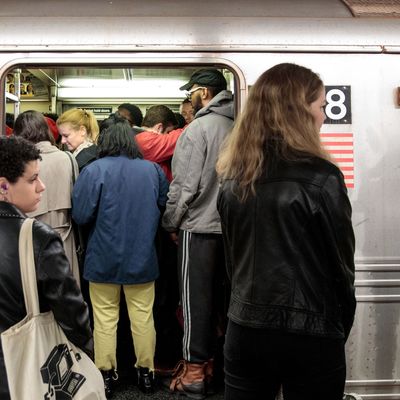
“The subway system is no doubt in distress and we’re here for solutions,” MTA chairman Joe Lhota said Tuesday as he delivered the authority’s subway action plan. The $836 million proposal is a product of the 30-day review called for under the MTA’s state of emergency, and focuses on ways to immediately improve service, and begin long-overdue upgrades and repairs.
A pilot program to remove seats from some cars to deal with overcrowding was one of the MTA’s splashier plans. The transit agency will experiment with the overcrowded L train and the Times Square–Grand Central shuttle to start, Lhota said, adding that this could help stuff up to 25 more riders into each car.
Lhota also promised to improve communication, revising the standby announcements — such as the (often rage-inducing) “delayed due to train traffic ahead” — to give commuters more detailed information about what’s actually going on in real time.
Also in the name of improving communication and accountability: an MTA “dashboard” system that will operate like the NYPD’s Compstat that will measure, among other categories, reliability and safety.
The MTA will deploy a slew of personnel to help tackle some of the common causes of delays, including EMT squads based at transit hubs to efficiently deal with those “sick passengers.” The authority will also expand its Combined Action Teams, which are rapidly dispatched to deal with mechanical and track issues that slow the subways on a now-daily basis.
And then there’s the immediate station and infrastructure improvements. The MTA will increase its overhaul of subway cars, and add cars to trains where it’s possible. The agency will also do triple-heavy-duty cleaning at stations, and target “hot spots” to clear tracks of trash, water, and other debris. And the MTA will expedite plans to fix 1,300 of the most problematic signals by 2018.
These changes, and more, are part of phase one of the plan. There’s also a phase two, which will cover overhauls of the system — everything from a brand-new signal system to new subway cars — at the estimated cost of $8 billion. That healthy sum will likely be part of the next five-year capital plan in 2020 to 2024.
But as for phase one, Lhota assured reporters that “raising fares was not an option,” and suggested riders could start seeing a difference in their commutes “relatively quickly.” That’s the good news. Here’s the bad: Phase one will, as mentioned above, still cost more than $800 million (a little more than half will go to operating costs, the rest to capital repairs), which Lhota proposed should be split between the city and the state.
It appeared that Lhota struck a bit more of a conciliatory tone toward the mayor after a week of an escalating feud between Governor Andrew Cuomo and Mayor Bill de Blasio over who controls the subways, where the MTA chief seemed to side with Team Albany. Lhota delivered his plan a day after de Blasio introduced his own five-point plan to fix the subways — which included some suggestions embedded in the official MTA proposal, including that subway equivalent of Compstat idea. But de Blasio also spent part of Sunday riding the F train to demand Governor Cuomo “step up” and fix the subways, and to say the city won’t fork over any more money to the MTA until it more appropriately uses the resources it already has.
De Blasio repeated that point Tuesday at a press conference at the City Hall subway stop to discuss Lhota’s plan. Though interrupted by the subway and hecklers, the mayor insisted the city would not to give additional funds to the MTA.
De Blasio did give the MTA’s action plan pretty decent reviews, calling it an “important first step.” But his refusal to entertain Lhota’s money ask could very well set up yet another showdown between Albany and City Hall.
Meanwhile, Cuomo is reportedly heading to Washington, D.C., on Wednesday to talk “infrastructure needs” with the Secretary of Transportation, though he has praised the MTA proposal as “substantive and realistic.” He added, for the record, “I am fully committed to making it a reality.”
This post has been updated with de Blasio’s comments.





























